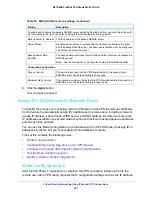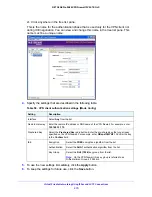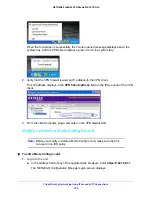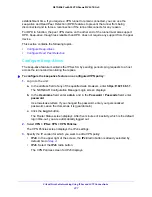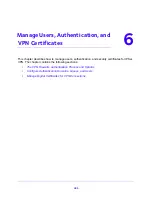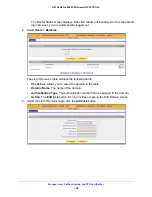
Virtual Private Networking Using IPSec and L2TP Connections
273
NETGEAR ProSAFE VPN Firewall FVS318G v2
4.
Specify the settings that are described in the following table.
5.
To use the new settings immediately, click the
Apply
button.
6.
To keep the settings for future use, click the
Save
button.
Configure the Mode Config Global Parameters
To specify the global parameters:
1.
Right-click the VPN client icon in your Windows system tray, and select
Configuration
Panel
.
The Configuration Panel screen displays.
Table 60. VPN client IPSec configuration settings (Mode Config)
Setting
Description
VPN Client
address
This field is masked out because Mode Config is selected. After an IPSec connection is
established, the IP address that is issued by the VPN firewall displays in this field.
Address Type
Select
Subnet address
from the list.
Remote host
address
The address that you must enter depends on whether you specified a LAN IP network
address in the
Local IP Address
field on the Add Mode Config Record screen of the
VPN firewall:
•
If you left the
Local IP Address
field blank, enter the VPN firewall’s default LAN IP
address as the remote host address that opens the VPN tunnel. For example, enter
192.168.1.1
.
•
If you specified a LAN IP network address in the
Local IP Address
field, enter the
address that you specified as the remote host address that opens the VPN tunnel.
Subnet mask
Enter
255.255.255.0
as the remote subnet mask of the VPN firewall that opens the VPN
tunnel. This is the LAN IP subnet mask that you specified in the
Local Subnet Mask
field
on the Add Mode Config Record screen of the VPN firewall. If you left the
Local Subnet
Mask
field blank, enter the VPN firewall’s default IP subnet mask.
ESP
Encryption
From the list, select
3DES
as the encryption algorithm.
Authentication
From the list, select
SHA-1
as the authentication algorithm.
Mode
From the list, select
Tunnel
as the encapsulation mode.
PFS and Group Select the
PFS
check box, and select the
DH2 (1024)
key group from the list.
Note:
On the VPN firewall, this key group is referred to as Diffie-Hellman Group 2 (1024
bit).



